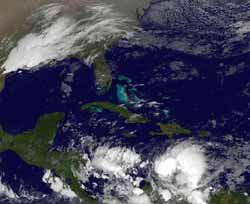GOES-13 catches Tropical Storm Tomas' early morning strengthening

The GOES-13 satellite captured a strengthening Tropical Storm Tomas this morning, Nov. 2 at 0845 UTC (4:45 a.m. EDT) in infrared imagery. Tomas appears as the rounded area of clouds (bottom right) about 310 miles due south of Port Au Prince, Haiti. In the larger image, the clouds over northwestern Louisiana (top left) are from a low and associated cold front stretching southwest to north-central Mexico.<br>Credit: NOAA/NASA GOES Project<br><br>
The Geostationary Operational Environmental Satellites like GOES-13 are managed by NOAA. The NASA GOES Project at NASA's Goddard Space Flight Center in Greenbelt, Md. creates images and animations from the GOES satellite data. When GOES-13 provided an infrared image (because it was taken at night) today, Nov. 2 at 0845 UTC (4:45 a.m. EDT), Tropical Storm Tomas showed a little more organization in its clouds after battling wind shear yesterday.
Infrared satellite data also showed that convection (rapidly rising air that form the thunderstorms that make up a tropical cyclone) has increased or deepened in Tomas. This morning most of that convection and thunderstorm activity is occurring over the eastern and northeastern areas around the center of circulation.
The wind shear over the south-central Caribbean Sea has weakened which has allowed Tomas to gradually re-strengthen. The waters are also much warmer than the 80 degree threshold needed to maintain or strengthen a tropical cyclone. Because of these improving conditions, the National Hurricane Center forecasts that Tomas will continue strengthening until Friday when an upper-level trough (elongated area of low pressure) will push Tomas north-northeastward toward the Windward Passage and parts of Hispaniola.
At 5 a.m. EDT, Tropical Storm Tomas had maximum sustained winds near 50 mph (up from 45 mph on Nov. 1). Tomas is moving west near 12 mph and has a minimum central pressure of 1003 millibars. The center of Tomas is located about 355 miles south of Port-au-Prince, Haiti near 13.5 North and 72.0 West. Tomas is being steered along the southern and southwestern edge of ridge (an elongated area) of high pressure which is moving Tomas west.
To visualize Tomas' movement, picture a penny on a table and move your finger from the bottom of the penny to the left. The penny is the area of high pressure, and your finger would be Tomas. High pressure areas act as a wall that tropical cyclones can't penetrate, so they move around the edges.
Tomas is forecast to become a hurricane on Thursday, Nov. 4 and turn to the northeast, threatening Haiti. Currently there are no watches and warnings in effect, but that's likely to change later this week.
Media Contact
More Information:
http://www.nasa.govAll latest news from the category: Earth Sciences
Earth Sciences (also referred to as Geosciences), which deals with basic issues surrounding our planet, plays a vital role in the area of energy and raw materials supply.
Earth Sciences comprises subjects such as geology, geography, geological informatics, paleontology, mineralogy, petrography, crystallography, geophysics, geodesy, glaciology, cartography, photogrammetry, meteorology and seismology, early-warning systems, earthquake research and polar research.
Newest articles

“Nanostitches” enable lighter and tougher composite materials
In research that may lead to next-generation airplanes and spacecraft, MIT engineers used carbon nanotubes to prevent cracking in multilayered composites. To save on fuel and reduce aircraft emissions, engineers…

Trash to treasure
Researchers turn metal waste into catalyst for hydrogen. Scientists have found a way to transform metal waste into a highly efficient catalyst to make hydrogen from water, a discovery that…

Real-time detection of infectious disease viruses
… by searching for molecular fingerprinting. A research team consisting of Professor Kyoung-Duck Park and Taeyoung Moon and Huitae Joo, PhD candidates, from the Department of Physics at Pohang University…




















